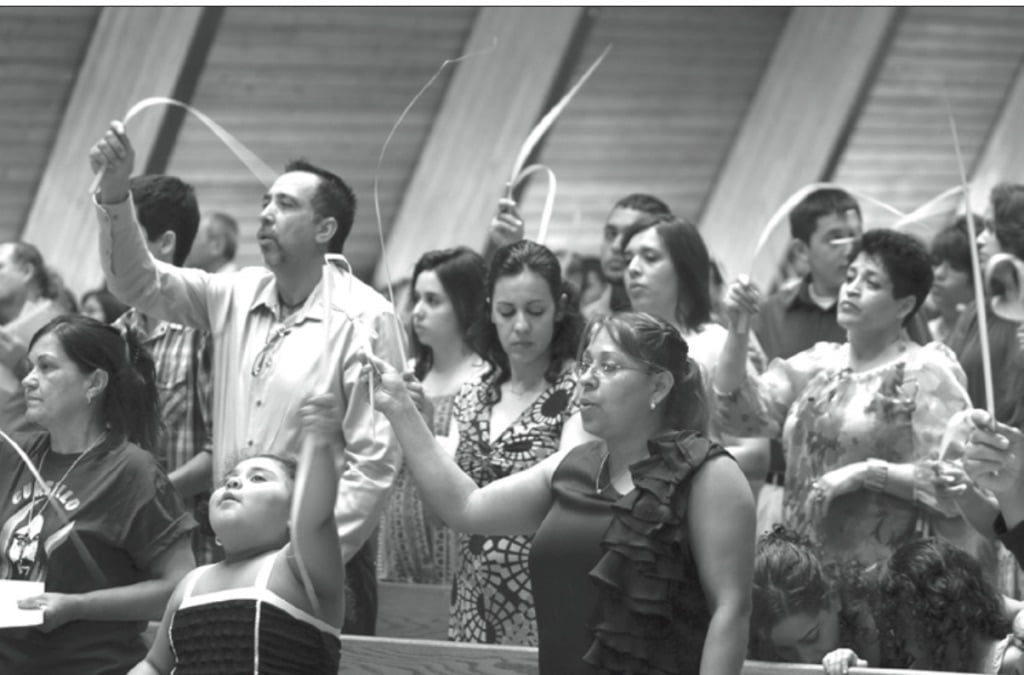
Palm Sunday marked the first Spanish- language Mass at St. Patrick Parish in Kansas City, Kan. Nearly 300 people attended the celebration.
by Joe Bollig
joe.bollig@theleaven.org
KANSAS CITY, Kan. — Tony Valenzuela works only two blocks from St. Patrick Parish here, but his shadow never darkened its door.
Valenzuela used to drive for nearly a half hour for Sunday Mass at St. Mary-St. Anthony Parish in Kansas City, Kan. It was the closest Spanish-language Mass he could find.
All that changed on Palm Sunday, April 1, when St. Patrick Parish inaugurated a new era of Hispanic ministry with its first regularly scheduled Spanish-language Mass.
Nearly 300 people attended the Palm Sunday Mass. The main celebrant was Father Pat Murphy, CS, archdiocesan animator for Hispanic ministry; St. Patrick’s pastor Msgr. Michael Mullen concelebrated. A reception with Mexican-style sweet breads and hot chocolate was held after the Mass.
“It is a great pleasure and privilege for me to welcome you to St. Patrick Parish and to our Palm Sunday celebration today,” said Msgr. Mullen in his welcoming remarks, which were translated by Father Pat.
“It is a joy for us to be celebrating our first Sunday Mass in Spanish,” he continued. “I thank all of you for coming and invite you not only to return each Sunday, but also to reach out and invite others . . . to come.”
Father Pat will celebrate the Spanish-language Masses, which will be held at 2 p.m. each Sunday.
The area roughly bounded by western Kansas City, Kan., Tonganoxie and De Soto has seen an increase in the number of Spanish-speaking Catholics, many of whom have roots in Mexico.
For them, Spanish is the primary language in the home, and they had to drive long distances for a Spanish-language Mass.
“Some people [go to] Kansas City, Kansas, and others go to Olathe or Lawrence,” said Valenzuela.
Others would get discouraged and simply not go to Mass, or would be enticed to leave the Catholic faith through proselytizing by other Christian denominations and sects.
The effort to bring a Spanish-language Mass to St. Patrick Parish began two years ago, when a group of Spanish-speaking Catholics from this underserved area approached Father Pat.
“We began a process of meeting with them,” said Father Pat. “The first thing they did was go around and ask families if they wanted a Mass in Spanish closer to home. Of course, they said yes.
“So we started meeting with the leaders and, over the past two years, we’ve had retreats and celebrations at the Bonner Springs Community Center,” he said, “always with the goal that we’d find a place that would accept them and have Mass in Spanish.”
The first parish that said “yes” was St. Patrick. The first Spanish-speaking leadership meeting at St. Patrick was on March 17 — providentially, St. Patrick’s Day.
“[Msgr. Mullen] was so wonderful,” said Valenzuela. “He showed us the whole church and all around the buildings. We felt so welcome. I don’t know how to explain it. He’s such a great person.”
Msgr. Mullen made jaws drop when he suggested quite readily some places where they might display an image of Our Lady of Guadalupe, who is revered by Hispanic Catholics.
“Usually it’s a sign you’ve made it when you can put up an image of Our Lady of Guadalupe,” said Father Pat.
Most of the new Spanish-speaking families joining the parish are married couples, aged 30 to 40, with children. Even before the first Mass, some had already enrolled their children in the parish school and religious education program.
Many of these families are eager to sign up for all sorts of ministries, said Ramiro Valenzuela, brother of Tony Valenzuela. Some established members of the parish who can speak Spanish are acting as a “bridge” to facilitate the new parishioners.
“We want to keep the church the way it is,” he said. “We don’t want to change anything, and we don’t want to interfere with other services and meetings. We want to add to what they have and to work with them. We want to form one community.”
That attitude started at the top, with Msgr. Mullen working from the outset to build a climate of acceptance and inclusiveness.
“About three weeks before Palm Sunday, I spoke at all the Masses to the regular parishioners to describe the program taking place,” he said.
“I emphasized that we wanted to continue to be one parish, and we didn’t want parallel organizations,” he continued. “We want rather to work as one. I laid that out as a general invitation to everyone to welcome these new parishioners as they had to others in the past.”
He’s already looking forward to having the new, Spanish-speaking parishioners represented on the parish and finance councils, the school board, social committees and other organizations. The parish has plans for some staff to learn Spanish, as he will try to do himself.
“I told them,” concluded Msgr. Mullen, “that I might learn Spanish — but it will be with an Irish accent!”






